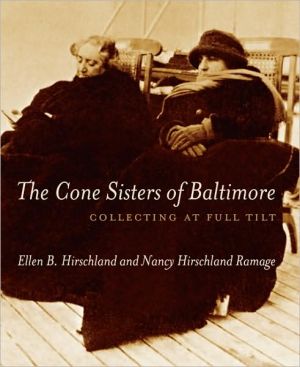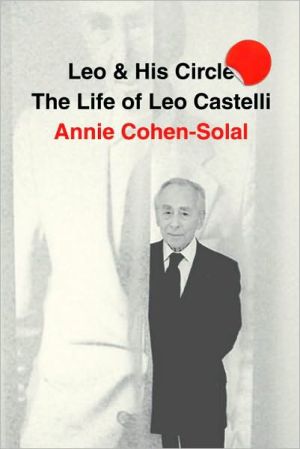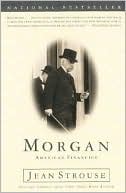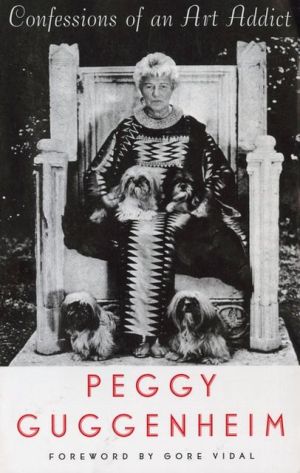Cone Sisters of Baltimore: Collecting at Full Tilt
Over a period of fifty years, sisters Claribel and Etta Cone amassed one of the most acclaimed collections of late-nineteenth and twentieth-century art in America. Dr. Claribel and Miss Etta were two halves of an idiosyncratic team—Claribel bold and assertive and Etta reflective and sensitive—who used the fortunes of their German Jewish immigrant family to seek out works that inspired and pleased them, regardless of public opinion and with only self-taught expertise.\ This richly illustrated...
Search in google:
Over a period of fifty years, sisters Claribel and Etta Cone amassed one of the most acclaimed collections of late-nineteenth and twentieth-century art in America. Dr. Claribel and Miss Etta were two halves of an idiosyncratic team—Claribel bold and assertive and Etta reflective and sensitive—who used the fortunes of their German Jewish immigrant family to seek out works that inspired and pleased them, regardless of public opinion and with only self-taught expertise.This richly illustrated biography documents their lives from a unique perspective: that of their great-niece, who wrote this book with her daughter. Ellen B. Hirschland and Nancy Hirschland Ramage delve into Claribel’s and Etta’s world, following the sisters through letters and personal stories as they travel to meet some of the artists whose works would turn their adjoining apartments into a gallery. They bought art by Manet, Gauguin, and Cézanne, as well as of Picasso and Matisse, whom they came to know well. The sisters’ experiences in Paris from 1901 through the 1920s provide an exceptional view of the bright artistic ferment in the city at that time. They were two Victorian women from Baltimore buying avant-garde masterpieces, attending salons with friends Gertrude and Leo Stein, and building a collection that would initially enrage the conservative people around them. Only with time would their keen eyes and unwavering taste prove them right.
The Cone Sisters of Baltimore\ COLLECTING AT FULL TILT \ \ \ By Ellen B. Hirschland Nancy Hirschland Ramage \ NORTHWESTERN UNIVERSITY PRESS \ Copyright © 2008 \ Northwestern University Press\ All right reserved.\ \ ISBN: 978-0-8101-2481-3 \ \ \ \ \ Chapter One Presenting Miss Etta and Dr. Claribel \ The Cone sisters exuded an aura of stateliness and dignity. In later years their old-fashioned formality, petticoats, and portliness-combined with the awe inspired by their unique collection of art-made them formidable indeed. Blinded by these trappings, people tend to speak of them as a unit. Yet it would be hard to find two people more different in personality, actions, or desires.\ In her peculiarly impenetrable way, Gertrude Stein-a longtime friend of the Cones-proclaimed them to be quite different as early as 1912, when Claribel was forty-eight and Etta forty-two. The differences separating the sisters also fascinated Gertrude's companion, Alice B. Toklas. In public Alice exchanged polite greetings with her lover's old friends, but behind their backs never missed the chance for a catty remark about Etta. Alice seemed particularly jealous of her because of Etta's early close relationship with Gertrude. In using Toklas as a source of information about the Cones, it should always be kept in mind that Alice fancied Etta to be her rival for Gertrude Stein's affections. "Dr. Claribel," she wrote of her first meeting with the Cone sisters, was "handsome and distinguished, Miss Etta not at all so."\ Dr. Claribel, who did not return the compliment, would often avoid going to functions when she knew Alice would be there. But too well-bred to indulge in open nastiness even in private, the Cones expressed their dislike rather by ignoring Alice or mangling her last name when writing to Gertrude.\ For all of her ill will, Alice eventually admitted that Etta was an "astounding, colossal personality"-at the same time that she belittled Etta's great accomplishment by deeming the relationship between her and Claribel more fascinating than their collection, and assuming, inaccurately, that most of the important pictures were bought by Dr. Claribel.\ Claribel Cone-the older, bolder, and shorter of this interesting pair-made up in majesty and girth what she lacked in height. Her independent nature asserted itself early. At age twenty-three, she overcame her parents' resistance and entered medical school. Graduating just three years later, in 1890, she joined the select coterie of female physicians, which then numbered only a handful worldwide.\ Claribel conversed with intelligence and spirit, not only about her profession (medicine) and her avocation (art) but also about politics and music. Fully conscious of her dignity as a "lady," she nonetheless cultivated idiosyncrasies that set her apart from the crowd. Her letters to Etta are filled with stories of how one distinguished person after another complimented her or sought her out. Perhaps her most characteristic trait was a seamless confidence in her own judgment, which gave her the courage to follow her own mind without regard for convention. She was active in women's suffrage, medical education for women, the drive for better conditions in maternity hospitals, and birth registration.\ Yet the independent and intelligent Claribel was also considered self-absorbed and unapproachable. Within her family she overshadowed her eleven brothers and sisters alike. At age nineteen, one sibling taxed her with being "too self-satisfied," and she did not hesitate to make fun of her more retiring sister Etta in front of other people. In such a mood she could be vitriolic and even cruel. Yet all her life she regarded Etta as her closest friend and confidante. Early on, she planned to leave everything she had to Etta, who enjoyed her complete trust.\ Flamboyant, egotistical, and self-assured, Claribel enjoyed the strong impression she made on others. Quoting to Etta a compliment paid to her by a new acquaintance, she demurred with pretended modesty, "Dare I repeat it?" and then went on to do just that, reporting that the lady thought she looked "like a queen." Indeed, like a queen, Claribel took exceedingly good care of herself while remaining largely impervious to the needs and difficulties of those around her.\ One such difficulty was caused by her abrupt defection into medicine, which left Etta, the last remaining girl in a large family, to oversee the running of their aging parents' household. As responsible and caring as Claribel was independent and self-absorbed, Etta was not one to shirk her responsibilities.\ Etta spent much of her life caring for relatives-her parents until their death, then her widowed sister-in-law. What time she had to herself she devoted to music-she was an accomplished pianist-and to the study and acquisition of modern art. In contrast to Claribel's marked preference for all things German, Etta preferred the people and culture of France. She spent most of her time abroad there and spoke reasonably good French, albeit with an American accent.\ Etta's long face, heavy chin, and straight Cone mouth-so far from the Gibson girl ideal of beauty-ensured that she would never be considered pretty. Yet both artist and camera capture the beauty of her remarkable eyes-large, dark, and filled with sensitive and intelligent attentiveness. Photographed in her youth or in the company of her sister and their flamboyant friend Gertrude Stein, Etta appears dreamy and retiring. But in later years, when her white hair and dark eyebrows magnified the effect of her fine eyes and her straight carriage underscored her quiet dignity, the impression was of a woman who was sensitive, yet handsome and strong.\ For the most part, Etta accepted her subordination to Claribel. She once wrote jokingly to Gertrude Stein that something would happen "if all goes my way-which is mostly my sister's way." Claribel, too, knew that she tended to overpower Etta and may have been referring to such an incident in this brief and somewhat cryptic note to herself:\ P.M. 2 o'clock - to Etta's room Housemaid Cleaning brushing 7 pieces of clothing for me Etta nervous over Mrs. G and perhaps me ...\ An incident in Paris in 1927 illustrates the sisters' very different ways of handling an awkward situation. One day Gertrude Stein asked her friend Etta Cone to visit the composer Virgil Thomson. Gertrude assured Etta that Thomson had real talent, in the hope that the tenderhearted Etta might offer him assistance in his poverty. Not long thereafter, the Cone sisters and their friend Nora ("Mac," as Etta called her) Kaufman visited Thomson in his sparsely furnished room, which contained his bed, a chest, an upright piano, and two chairs.\ Claribel and Etta occupied the chairs while Mac sat on a third, borrowed chair, which had been placed in the doorway. Virgil Thomson sat on the piano stool and played for them the music that he was just then composing for Gertrude's opera, Four Saints in Three Acts. Both Cone sisters drifted off to sleep. Just in time for the end of the performance, Mac cleared her throat and woke them. With her characteristic quick wit, Claribel immediately came up with a gracious comment about the music, while the slower and obviously embarrassed response of her more sensitive sister only made her inattention more obvious. The incident is preserved for us only because it made enough of an impression on Nora that she remembered it across the years and relayed it to Etta's great-niece Ellen Hirschland, who noted the retelling thus:\ Nora Kaufman recollected this story to me about forty years after it occured. Oddly enough, shortly thereafter I had the opportunity to spend an evening with Virgil Thomson at the home of the artist Robert Indiana. He remembered well the visit of my aunts but made no comment-whether from politeness or from not having remembered it-of their inattention to the music.\ In their later years, when both Claribel and Etta grew portly and their unique style of dress became ever more out of step with the times, strangers may be forgiven for failing to distinguish between them. The sisters designed their own clothes and had them made in Paris by a Madame George. Both dressed conservatively-although they drew the line at the Victorian bone collars favored by their still more austere sister-in-law, Bertha, the wife of their brother Moses.\ In her youth, Etta generally wore white, lavender, or black. When traveling, both sisters, as well as their friend Gertrude Stein, favored the dark skirt and shirtwaist (a full-sleeved, high-necked white blouse) worn by fashionable young women in the years preceding World War I.\ In later years, both Cone sisters almost invariably dressed in black. Their dresses were made of the best-quality fabric and adorned with braid or other fine trim. Impervious to changes in fashion, they yet appeared perfectly groomed in every detail, giving a polished effect.\ Throughout the flapper days, when skirts went knee high, Claribel and Etta modestly continued to wear their dresses floor length. No part of the legs showed above the black stockings and heavy black walking shoes. Nora Kaufman recollected this story to me about forty years after it occurred. Oddly enough, shortly thereafter I had the opportunity to spend an evening with Virgil Thomson at the home of the artist Robert Indiana. He remembered well the visit of my aunts but made no comment-whether from politeness or from not having remembered it-of their inattention to the music.\ Voicing a rather modern complaint, Etta claimed she needed flat shoes for comfort and wondered how other women managed to walk in high heels. Once while traveling with her great-aunt, Ellen Hirschland tried an experiment:\ I persuaded her, in a hotel room, to try on a pair of my high-heeled shoes, and she walked around the room merrily like a child with a new toy. Perhaps she had hankered to make this experiment for a long time. But despite her obvious delight, her style in footwear never changed.\ Claribel occasionally sported a dramatic broad-brimmed hat but more frequently preferred the tailored narrow-brimmed style. She would drape a scarf aristocratically around her throat and accent it with a colorful pin, selected with care from her extensive collection. The tableau was completed by black gloves and a slim black umbrella with an engraved silver handle. This last served not only the customary purpose of protecting her from the rain but was also used on occasion to ward off bats. In one of her few surviving letters, Etta describes such a scene to Gertrude Stein:\ Sister C. has a new method of seeing cathedrals, [take, for instance,] Ely Cathedral. She goes through with her umbrella open over her ... Now the reason why my sister goes through Ely Cathedral with her umbrella raised, is because several bats have selected the Ely Cathedral as the scene of their wanderings also.\ You can picture the scene.\ The impression of massiveness produced by both sisters was due in part to their habit of wearing voluminous petticoats. The outermost of these remarkable undergarments contained a large pocket, just below the knee, for keeping money and keys. Ellen Hirschland recalled that when it came time to pay, this arrangement-combined with her Aunt Etta's preference for newly printed bills-led to some amusing situations.\ In restaurants Etta would rustle about under the table, reaching beneath her dress into her petticoat for her money. Both slip and dress were black, making it difficult for a curious outsider to observe what was going on. Since Etta almost always used newly printed money, however, the bills had a tendency to stick together. Instead of paying $20, for instance, she would hand out $40 or $60 by mistake. Waiters astonished in the first place to see this hoard appear mysteriously from under the tablecloth were dumbfounded when the amount was so wrong. But in my experience they invariably pointed out the error.\ When venturing out, Etta also carried a black leather purse to keep tickets, a handkerchief, and other such items. She did not use cosmetics. But at home, whenever the household help asked for change for a deliveryman, the skirt search would commence in the open. The ample coverage provided by the next layer of petticoat ensured complete modesty during this rummaging in what Etta called her "underground pocket."\ Whatever tensions existed between the Cone sisters, they chose to travel and live together much of their lives, and the active correspondence they maintained with each other when apart bears eloquent testimony to the strength of their friendship.\ In the first years of the twentieth century, two young women-one timid, one bold-ventured across the ocean into a world unknown to the Baltimore of their youth. In the beginning they sought little more than a glimpse of the old World, a privilege granted to a few well-to-do Victorians before they settled down. They sailed headlong into the turmoil surrounding the birth of modern art and a revolution in Western aesthetics. At first accompanied by their friends the Steins and later alone, Claribel and Etta followed the true plumb line of their taste. Every year they searched artists' ateliers and dealers' shops and chose one modern masterpiece after another. Only Etta lived to see their life's work appreciated, but both sisters experienced deep and abiding pleasure in amassing their great collections and in living with them in their crowded, art-filled apartments.\ Chapter Two Impoverished Peddler to Prosperous Merchant\ When writing his inspirational stories for boys, Horatio Alger could well have been describing Herman Cone, for Herman's life can fairly be said to embody the American dream. Yet on June 3, 1828, the day Klara Marx Kahn gave birth to her tenth child in the small Bavarian town of Altenstadt-am-Iller, no one would have suspected the child was destined for great adventure. Klara and her husband, Moses (1781-April 28, 1853), named the child Herman. But Klara never recovered from the birth, and not long into the following year, she died. So life began for the man who would found the remarkable Cone dynasty.\ Herman Cone's Emigration to America\ In the first half of the nineteenth century, much of Europe was in political and social upheaval, but in Germany the twin evils of poverty and repression were particularly severe. Faced with dismal prospects for the future, young people and even whole families packed up and left for the New World. In 1840 an estimated thirty thousand Germans sailed for the United States; by 1854 that number had grown to two hundred thousand.\ If times were hard for all Germans, for German Jews they were wretched. Bavaria's laws ensured that its large and largely poor Jewish community stayed poor. Quotas were set on the number of Jews allowed to settle in any one area. Those permitted to stay were restricted to certain professions and forced to live in ever-more-heavily taxed ghettos. In addition to these age-old injustices, Jews faced the prospect of being conscripted into an army that made no provision for kosher foods or observance of the Saturday Sabbath. For the devout, army life meant an inescapable descent into sin.\ As the century progressed, more and more Jews-especially young, single men-ventured across the ocean to seek a better life. Among them was the seventeen-year-old Herman Kahn, who left Germany to join his married sister Elise in Richmond, Virginia, in 1846.\ Before he departed, young Herman received a letter from his brother-in-law Joseph Rosengart, married to another of his sisters. With profound sympathy for the teenager forced to leave home and family-perhaps never to see them again-Rosengart wrote eloquent words of comfort and advice (see appendix A).\ You may shed tears because you are leaving your parents' house, your Father, Brothers and Sisters, relatives, friends and your native land, but dry your tears, because you may have the sweet hope of finding a second home abroad and a new country where you will not be deprived of all political and civil rights and where the Jew is not excluded from the society of all other men and subject to the severest restriction, but you will find a real homeland where you as a human being may claim all human rights and human dignity.\ Armed with little more than a wise, eloquent, and loving letter-which he would treasure all his life, as did his descendants after him-the penniless young Herman arrived in Richmond. For a short time he stayed with the family of his sister Elise Kahn Hirsh, fifteen years his senior.\ (Continues...)\ \ \ \ \ Excerpted from The Cone Sisters of Baltimore by Ellen B. Hirschland Nancy Hirschland Ramage\ Copyright © 2008 by Northwestern University Press. Excerpted by permission.\ All rights reserved. No part of this excerpt may be reproduced or reprinted without permission in writing from the publisher.\ Excerpts are provided by Dial-A-Book Inc. solely for the personal use of visitors to this web site.\ \
Preface Chapter 1 — Presenting Miss Etta and Dr. Claribel Chapter 2 — Impoverished Peddler ato Prosperous Merchant Chapter 3 — Etta Opens the Door Chapter 4 — The Decided Doctor Claribel Chapter 5 — The Roaring Twenties - Collecting at Full Tilt Chapter 6 — Etta on Her Own Chapter 7 — Aftermath Sppendices Selected Bibliography








